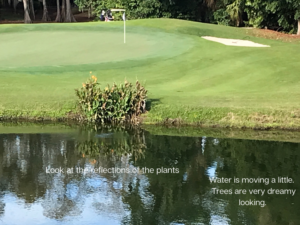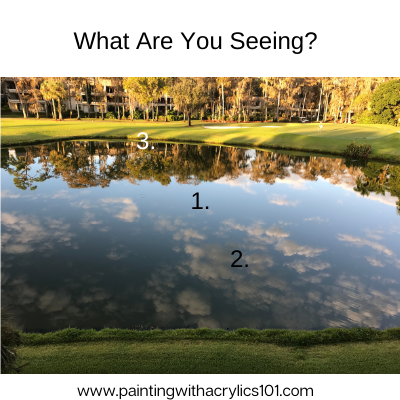How To Paint
Reflections in Water
Reflections are beautiful but they can be tricky for the beginner to paint effectively. It requires the artist to really look at the reflections they are painting.
I’m including some photos from a recent trip to Florida that has some beautiful reflections. I’ll point out some things the beginning artist needs to learn and remember.
Numbers on picture corresponds with first 3 points below.
- What is in the reflection? Whatever is above the water should be reflected in the water. That means sky, clouds, sun, moon, trees, grass on the edge, people, etc. When I paint a sky, I usually take that paint and dull it down just a bit with a complement and paint the water at the same time. There will be a blank space between the sky and the water usually, unless you’re painting the ocean.
- What color are the reflections? A white bird flying over the water will look white, but duller. White does not reflect as bright as the original item. Darker things look lighter and lighter things look darker. The difference may be minimal, but there is a difference.
- Still water – Still water is very glassy and practically a mirror image of what it is reflecting. Along the shore of still water there will be a darker line where the water meets the shore.
- Moving water – With moving water the reflected items will be less mirror like. They will be wavy and much less clear. It might be closer to a suggestion of the item and not a mirror image. You may also paint wavy brush strokes over the items. Also along the shore line of moving water, there will be a lighter, almost white line where the water laps up to the shore.

In the above photo, look at the reflections of the plants. They are painted straight down in the water. To the right the water is starting to move and the trees are not mirror images but are more dreamy looking.
You can barely see it, but to the right of the plants is a blue heron. You can actually see the bird in the reflection better than on the ground.

